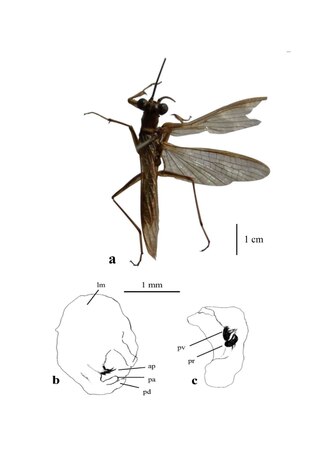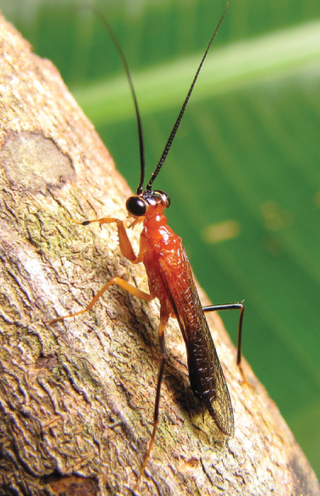
Metallyticus is a genus of praying mantis. It is the only genus in the monotypic family Metallyticidae. They are mostly found in South-East Asia. The species of the genus are dark, somewhat flattened and cockroach-like, and often with a cuticle that is reflective and metallic in appearance.

Mantoida is a genus of praying mantises in the family Mantoididae. The species of this genus are native to Mexico, Central America, and South America.

Hymenopus coronatus is a mantis from the tropical forests of Southeast Asia. It is known by various common names, including walking flower mantis, orchid-blossom mantis and (pink) orchid mantis. It is one of several species known as flower mantis, a reference to their unique physical form and behaviour, which often involves moving with a “swaying” motion, as if being “blown” in the breeze. Several species have evolved to mimic orchid flowers as a hunting and camouflaging strategy, “hiding” themselves in plain view and preying upon pollinating insects that visit the blooms. They are known to grab their prey with blinding speed.

Flower mantises are praying mantises that use a special form of camouflage referred to as aggressive mimicry, which they not only use to attract prey, but avoid predators as well. These insects have specific colorations and behaviors that mimic flowers in their surrounding habitats.

Mantoida brunneriana is a species of praying mantis in the family Mantoididae. It is found in Bolivia, Brazil, French Guiana, Paraguay, and Venezuela.
Mantoida fulgidipennis is a species of praying mantis in the family Mantoididae.

Ameles spallanzania, common name European dwarf mantis, is a species of praying mantis.

Mantoida nitida is a species of praying mantis in the family Mantoididae. It is found in Mexico.

Rhombodera is a genus of praying mantises native to Asia and possessing common names such as shield mantis, hood mantis, and leaf mantis because of their extended, leaf-like thoraxes.

Mantises are an order (Mantodea) of insects that contains over 2,400 species in about 460 genera in 33 families. The largest family is the Mantidae ("mantids"). Mantises are distributed worldwide in temperate and tropical habitats. They have triangular heads with bulging eyes supported on flexible necks. Their elongated bodies may or may not have wings, but all Mantodea have forelegs that are greatly enlarged and adapted for catching and gripping prey; their upright posture, while remaining stationary with forearms folded, has led to the common name praying mantis.

Mantoididae is a family of praying mantises which contains Neotropical species of praying mantises from tropical North and South America. The family was formerly represented by the sole genus Mantoida, until the genus Paramantoida was described in 2014 and Vespamantoida in 2019. The family differs from the closely related Chaeteessidae in having an apical claw on the fore tibiae which are also less curved. Males have ocelli and a cylindrical body shape, unlike the dorsoventrally flattened Chaeteessidae. The cerci are also shorter.
Charieis is a genus of mantids in the family Tarachodidae. It is a monotypic genus with a single recognised species, Charieis peeli.
Tropidomantis kawaharai is a species of praying mantis in the family Nanomantidae. It is endemic to the remote Marquesas Islands of French Polynesia in the southern Pacific Ocean. It was described from two specimens collected from the island of Hiva Oa. It is notable for being the first praying mantis species known from the archipelago.
Thespinae is a subfamily of mantises in the family Thespidae. There are 16 genera and at least 40 described species: found in most continents.

Vespamantoida wherleyi is a species of praying mantis that mimics a wasp. It was discovered in 2013 at a research station near the Amazon River in northern Peru. The discovery resulted in erecting a new genus, Vespamantoida. This mantis has a red/orange colored body and black pattern. Besides the coloration, it has the body shape of and displayed walking and antenna movements similar to a wasp. This mantis is closely related to Mantoida toulgoeti as both species have a distinct foreleg synapomorphy.

Pseudovates is a genus of praying mantis in the family Mantidae. There are more than 20 described species in the genus Pseudovates, and are found in North, Central, and South America.

The Hierodulinae are a subfamily of praying mantids, originally used by Brunner von Wattenwyl. It was restored as part of a major revision of mantid taxonomy, and now contains genera previously placed elsewhere in the family Mantidae.

Chlorocalis maternaschulzei is a species of praying mantis in the family Mantidae and tribe Hierodulini. Records of this species are from the seasonal tropical forests of Thailand and Vietnam; the type specimen is from Nakhon Ratchasima Province.
Podagrion mantis was first described in 1886 by W.H. Ashmead, and was the first species of its genus to have been described from the United States. All species in the genus are parasitoid wasps known only to parasitize mantids. They have been observed most often utilizing the egg case (ootheca) of Stagmomantis carolina, but have also been reported to choose S.limbata or Tenodera augustipennis as hosts, showing a high degree of specialization.












